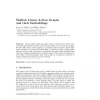67 search results - page 8 / 14 » Complexity Results on Graphs with Few Cliques |
WAW
2009
Springer
14 years 2 months ago
2009
Springer
The Modularity-Q measure of community structure is known to falsely ascribe community structure to random graphs, at least when it is naively applied. Although Q is motivated by a ...
FAC
2002
13 years 7 months ago
2002
Action calculi, which generalise process calculi such as Petri nets, -calculus and ambient calculus, have been presented in terms of action graphs. We here offer linear action grap...
CVPR
2009
IEEE
15 years 2 months ago
2009
IEEE
Higher order energy functions have the ability to encode
high level structural dependencies between pixels, which
have been shown to be extremely powerful for image labeling
pro...
COCOON
2005
Springer
14 years 1 months ago
2005
Springer
To monitor an electric power system by placing as few phase measurement units (PMUs) as possible is closely related to the famous vertex cover problem and domination problem in gr...
BMCBI
2007
13 years 7 months ago
2007
Background: Predicting protein complexes from experimental data remains a challenge due to limited resolution and stochastic errors of high-throughput methods. Current algorithms ...

